Apatosaurus, with its great size, great neck, and even greater tail, is the quintessential sauropod. Along with Stegosaurus, Triceratops, and Tyrannosaurus rex, it is one of those iconic dinosaurs that everyone recognizes instantly. Although it was long thought to have been the same animal as Brontosaurus, a 2015 study has concluded that the two were in fact separate genera.
The 2015 Papo Apatosaurus is meant to represent a juvenile. As such, its main body is slighter smaller than that of the Triceratops. But don’t get the idea that this animal is a runt. Far from it. From the curve in its neck to the tip of it tail, it measures 46 cm long. This makes it the longest prehistoric figure in the Papo line to date. You’re going to need a good length of shelf space to display this one!
As with nearly all Papo products, the Apatosaurus‘ colour scheme is nothing to write home about. Its main colour is medium brown with light brown for the underbelly and black wash stripes running along the length of its back. Its eyes are dark brown, its teeth are white, and the inside of its mouth is dull pink. The claws are unpainted, disappointingly.
Detail-wise, Papo once again knocks it out of the park. The many wrinkles on the skin of this growing giant give it a thick, leathery appearance. The tiny, peg-like teeth lining the front of the mouth are finely sculpted. The barely visible nostrils have been placed on top of the head, which is not in keeping with recent reconstructions. The neck is lined with rows of thick bumps to denote the huge bones beneath the skin and the tail terminates in a thin, whip-like tip. And unlike the Brachiosaurus, the Apatosaurus has the correct number of claws on each foot.
My fiancée, whom I always love to show off my new models to, doesn’t like the Apatosaurus. She feels that the neck is way too fat and disproportionate to the rest of the animal. And indeed, the neck does look odd. On the one hand, it’s extremely thick just like that of A. ajax. On the other hand, it’s also very deep like the neck of A. louisae. Perhaps the idea is that, as a juvenile, its proportions are supposed to be off. Or perhaps this individual is a hybrid. Either way, you really can’t get away with passing this toy off as Brontosaurus. The curvature of the neck is also intriguing. Some scientists have concluded that sauropods had very stiff necks. Others, however, argue that there was a much greater range of flexibility. The lack of soft tissue and cartilage make it virtually impossible to be certain. Personally, I prefer a flexible neck like this one.
This Apatosaurus is in a lumbering pose with its left heel raised slightly, its massive neck craned to look back over its right shoulder, and its mouth wide open. It could be turning its head to munch on some choice greens, but it could just as easily be bellowing in agitation and fear as a hungry Allosaurus pursues it. Will it be able to get to the safety of its herd in time? Could it fend off the predator on its own? Its fate rests in your hands!
The Papo Apatosaurus is small enough that it won’t put too deep of a hole in your wallet, and won’t require a particularly tall shelf, but it is also big enough to still be imposing. And aside from the nostrils and possibly too big a neck, it’s one of the more accurate dinosaurs Papo has released thus far. Children and adults alike should be very pleased with it indeed. Available from Amazon.com here.
//
Disclaimer: links to Ebay and Amazon on the DinoToyBlog are affiliate links, so we make a small commission if you use them. Thanks for supporting us!



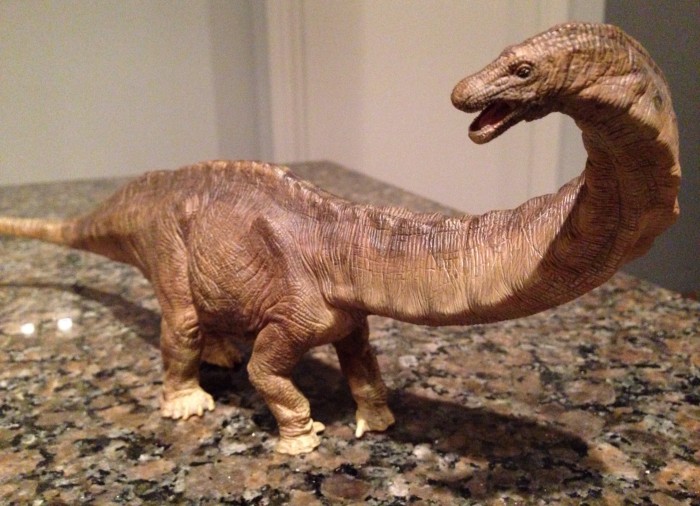
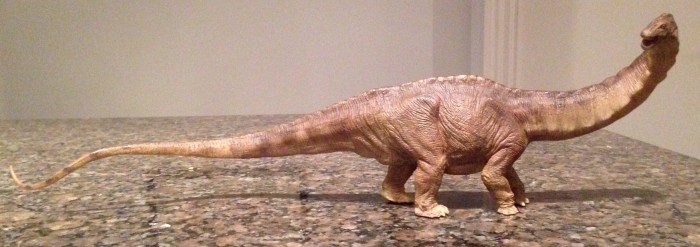

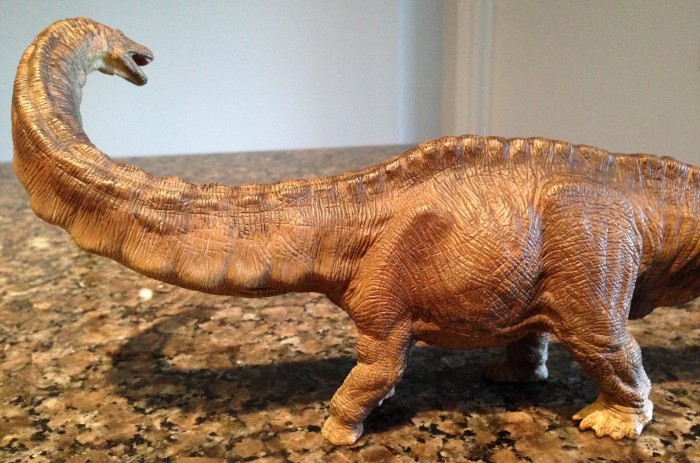
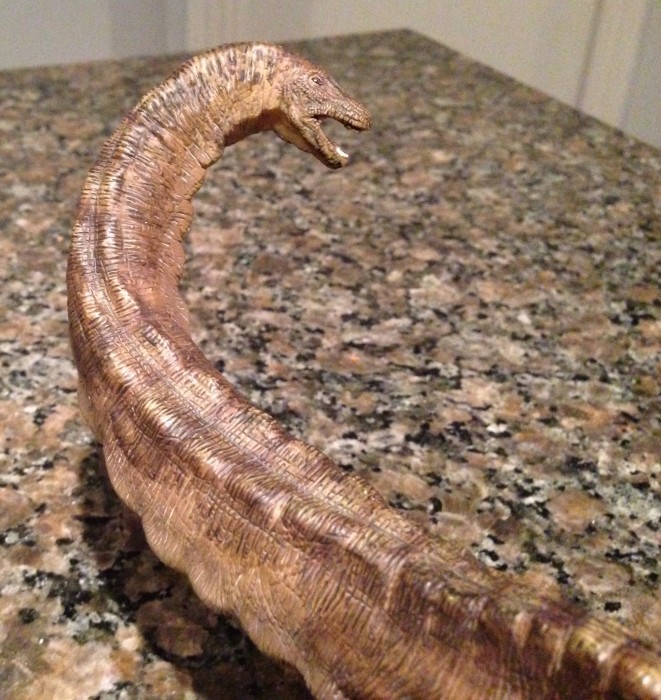
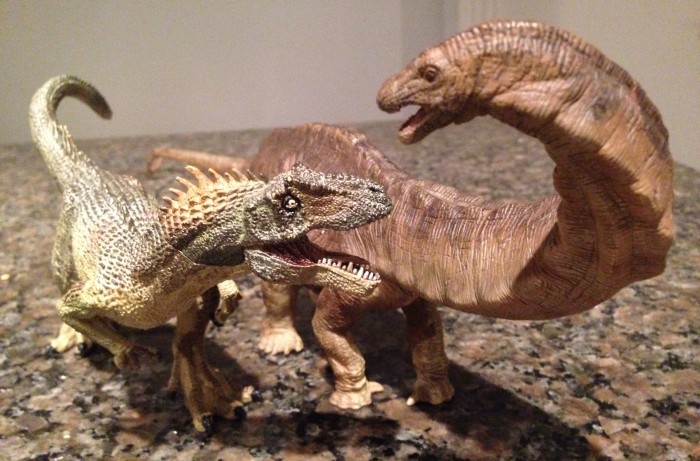

In teh meanwhile, I would like to ask to the more expert collectionists which is the best apatosaurus model on the market in the same range of price of Papo’s, and which is the top reference without considering the price. Thanks in advance.
I actually think this is the best plastic Apatosaurus out there. The Safari 2010 edition is also very good. Without regard to price, I would say the nicest one is the Sideshow Dinosauria Apatosaurus resin statue sculpted by Jorge Blanco.
Thanks Halichoeres, I didn’t knew the 2010 Safari Apatosaurus, I like very much the posture of the tail, and the neck looks more proportionate, but the details are not as good as in Papo’s one, that has a detailed open mouth that I like. Overall, I am happy with my Papo version, that allowed me to enter directly with bones ad soft tissues explainations with my son. He is magnetically attracted by the neck details, that goes on touching and exploring, and I believe this is going to be something he will fix well in his memory, since he aestetically loves so much his new toy. I will show Safari’s one now, to point out a less charming but more realistic rendition of the animal.
It’s fun to have this blog where to read and write. Thanks again.
I read some reviews of this model, and while I, 46 yo dad, would prefer a more realistic shaping of the neck, it is being a very useful recnstruction to show to my 9 yo son how a sauropod neck is made under the skin and the soft tissues, and I am so happy with it. My son is getting curious about the real aspect of older animals through the critical comprhension of their inner structure. This is the reason why i went really happy with this Papo a bit odd looking Apatosaurus.
I’m glad I’m not the only one who’s put off by its weird-looking neck. It looks like an anaconda that swallowed an elephant but didn’t get to digest it and now, it’s stuck inside its guts and trying to walk away. Poor things…..
I totally agree with ya! 😀
Nice review and pictures, but I agree with the author’s fiancée – that neck is really ill-proportioned and ugly! I can’t for the life of me think why the artist would restore the animal with such protrubant vertebrae. Can anyone suggest a living vertebrate whose bones poke out from the skin like that… except in cases where the animal is seriously malnourished and unhealthy? The legs also seem almost comically short to me, as if the belly would have a hard time clearing low-growing vegetation. I’m afraid I don’t find it remotely convincing as a restoration of a viable living animal.
I think the neck looks like it’s from a larger animal, proportion-wise. Not even the depth of the neck, but its length and overall size.
I’m inclined to agree with Mr. Martyniuk. The location of the external nares at the top of the skull should be regarded as an inaccuracy at this point.
“The nostrils, which are barely visible, have been placed on top of the head, which remains a topic of paleontological debate.”
Not to nitpick, but is there anybody who has argued against Witmer’s hypothesis? I thought the “debate” was over before it started.
Confession time: I recall there being a couple of debates about Witmer’s conclusions in the years following his 2001 study, but I’m afraid I don’t recall the scientist in question. Perhaps he’s changed his mind since. I wrote that sentence intending for it to be diplomatic, but it comes off badly, doesn’t it? I’m all for the new nostril placement myself. I should rephrase.
To me next to Sauropelta, and other figures of this year’s Safari and Tupuxuara Papo and guidraco and Pliosaurus Collecta apart from other outstanding figures like dinosaurs 2015 Battat to name a few; the apatosaurus Papo is one of the better and more detailed figures made especially more convincing from the point of view paleontological.
I especially like Papo although many of his figures are not accurate from the point of paleontological view their hyperrealism and the most important thing and I know I’m in this case contrary to the author I like in figures like that or Safari that these figures are painted an austere way seems more realistic painted with multiple colors as they give an unrealistic dinosaur prehistoric animal in question or image.
On the other hand I find myself at Papo and the same can be said of Wild Safari in relation to release its figures of prehistoric animals in early dates every year with exceptions such as the brachiosaurus Papo.
I understand that this attitude should have all companies and allow us especially collectors as soon as possible enjoy the latest news of dinosaurs every year.